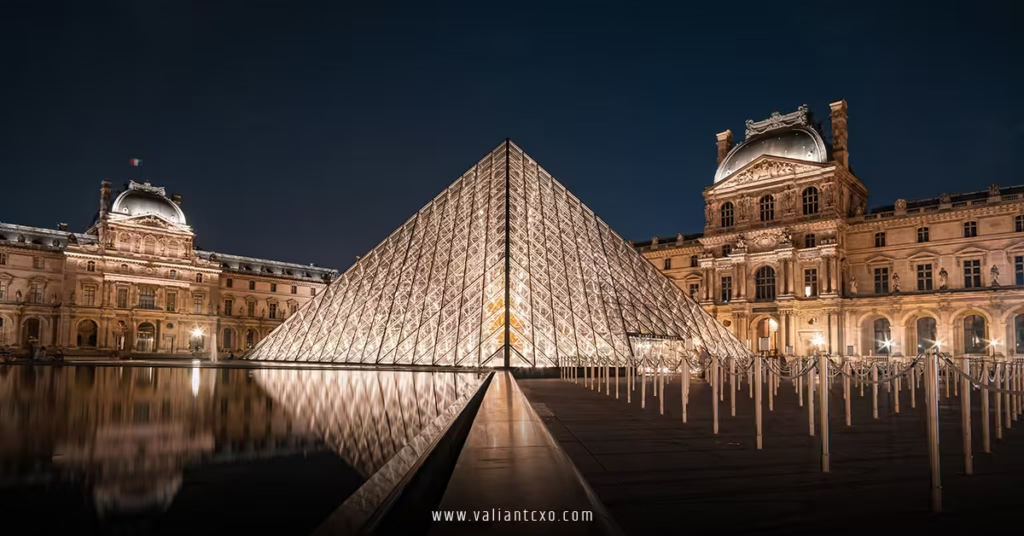Louvre Museum history and architecture overview begins with a story of transformation, from a medieval fortress to the world’s most iconic art museum. Nestled along the Seine River in Paris, the Louvre is more than a repository of art—it’s a living testament to centuries of human creativity, ambition, and reinvention. Have you ever wondered how a 12th-century castle became a global cultural beacon? Let’s dive into the rich tapestry of the Louvre’s past and its architectural evolution, exploring how this grand structure mirrors the pulse of history itself.
The Origins of the Louvre: A Fortress Born in Conflict
From Defensive Stronghold to Royal Residence
The Louvre Museum history and architecture overview starts in the late 12th century when King Philip II built a fortress to protect Paris from invaders. Picture a sturdy, no-nonsense castle with thick stone walls, a moat, and a massive keep—designed to intimidate rather than inspire. This was the Louvre’s first chapter, a military bastion meant to guard the city’s western flank. By the 14th century, as Paris grew safer, the fortress began its transformation. King Charles V turned it into a royal residence, softening its rough edges with tapestries and treasures. Can you imagine living in a castle that once bristled with soldiers but now sparkled with royal splendor?
Early Architectural Features
The original Louvre was all about function over form. Its thick walls, narrow windows, and defensive moat screamed practicality. The central keep, known as the Grosse Tour, stood as the heart of the fortress, a symbol of power. Little of this medieval structure remains today, but archaeological excavations beneath the Louvre’s Cour Carrée reveal its foundations. These remnants whisper stories of a time when the Louvre was a shield, not a showcase. The Louvre Museum history and architecture overview shows how even the grandest buildings start with humble, practical roots.
The Renaissance Rebirth: A Palace Takes Shape
Francis I and the Birth of a Cultural Hub
Fast forward to the 16th century, and the Louvre Museum history and architecture overview takes a dramatic turn under King Francis I. A lover of art and Renaissance ideals, Francis I decided the old fortress was outdated. He demolished the Grosse Tour and commissioned architect Pierre Lescot to design a new wing, blending French tradition with Italian Renaissance elegance. The result? The Lescot Wing, with its intricate carvings, tall windows, and harmonious proportions. It’s like the Louvre traded its armor for a tailored suit, stepping into a new era of sophistication.
The Role of Art in Shaping the Louvre
Francis I didn’t just redesign the building; he filled it with art. He acquired masterpieces like the Mona Lisa, laying the foundation for the Louvre’s future as a museum. His vision was clear: the Louvre wasn’t just a palace but a stage for cultural greatness. The Louvre Museum history and architecture overview reveals how this shift from fortress to palace set the stage for its museum destiny. Isn’t it wild to think that one king’s passion for art changed the course of a building’s history?
The Grand Design: Expanding the Louvre’s Footprint
The Vision of Catherine de’ Medici and Beyond
In the 16th and 17th centuries, the Louvre Museum history and architecture overview grew more ambitious. Catherine de’ Medici, a key figure in French history, spearheaded the Tuileries Palace, connecting it to the Louvre via the Grande Galerie—a long, riverside corridor. This expansion wasn’t just about space; it was about projecting power. The Grande Galerie, with its endless windows and ornate details, was like a ribbon tying the Louvre to the future. By the time Louis XIII and Louis XIV came along, the Louvre was a sprawling complex, though Louis XIV’s focus shifted to Versailles, leaving the Louvre temporarily in the shadows.
The Cour Carrée: A Renaissance Masterpiece
The Cour Carrée, a square courtyard surrounded by elegant wings, became the heart of the Louvre’s Renaissance transformation. Its symmetrical design, with intricate stonework and classical columns, feels like a love letter to balance and beauty. Walking through it today, you can almost hear the architects whispering, “This is what perfection looks like.” The Louvre Museum history and architecture overview shows how the Cour Carrée became a blueprint for the palace’s later expansions, blending form and function in a way that still captivates visitors.

The Birth of the Museum: A Public Treasure
The French Revolution and a New Purpose
The Louvre Museum history and architecture overview takes a revolutionary turn in the late 18th century. The French Revolution upended the monarchy, and the Louvre, once a royal playground, was reimagined as a public museum. In 1793, the Musée du Louvre opened its doors to the masses, showcasing art confiscated from the aristocracy and the church. Imagine the buzz in Paris as ordinary people walked through halls once reserved for kings. This shift wasn’t just about access—it was about democratizing culture. The Louvre became a symbol of enlightenment, proving that art belongs to everyone.
Napoleon’s Influence on the Louvre
Napoleon Bonaparte, ever the showman, supercharged the Louvre’s growth. He filled its galleries with treasures from his conquests, turning the museum into a trophy case for his empire. The Louvre Museum history and architecture overview highlights how Napoleon’s ambitions expanded the collection, though many pieces were later returned. His architects also added the Arc de Triomphe du Carrousel and began the northern wing, ensuring the Louvre’s grandeur matched his ego. Doesn’t it make you wonder how one man’s vision could leave such a lasting mark?
The Iconic Glass Pyramid: A Modern Marvel
I.M. Pei’s Bold Vision
The Louvre Museum history and architecture overview wouldn’t be complete without the glass pyramid, a 20th-century game-changer. In the 1980s, architect I.M. Pei proposed a daring addition: a glass and metal pyramid in the Cour Napoléon to serve as the museum’s new entrance. Critics howled, calling it a futuristic eyesore in a historic palace. But Pei’s vision was genius—a transparent beacon that married old and new. Today, the pyramid is as iconic as the Mona Lisa. It’s like the Louvre put on a pair of stylish glasses, proving it could stay relevant while honoring its past.
Architectural Harmony and Controversy
The pyramid’s sleek lines and reflective surfaces contrast with the Louvre’s classical facades, yet they work together like a symphony. The structure funnels light into the underground lobby, solving the museum’s overcrowding issues while creating a stunning focal point. The Louvre Museum history and architecture overview shows how Pei’s design sparked debate but ultimately won hearts, proving that bold architecture can redefine a landmark. Have you ever stood beneath the pyramid and felt the weight of history and innovation colliding?
Architectural Highlights of the Louvre Today
The Richelieu, Sully, and Denon Wings
The Louvre’s modern layout is divided into three main wings: Richelieu, Sully, and Denon. Each has its own personality, from the opulent apartments of Napoleon III in Richelieu to the ancient treasures of Sully and the blockbuster artworks in Denon. The Louvre Museum history and architecture overview reveals how these wings create a journey through time, with each corridor offering a new chapter. Walking through them feels like flipping through a history book where every page is a masterpiece.
The Louvre’s Exterior and Courtyards
The Louvre’s exterior is a masterclass in architectural diversity. The Renaissance elegance of the Lescot Wing contrasts with the baroque exuberance of the Colonnade, designed by Claude Perrault. The courtyards, like the Cour Carrée and Cour Napoléon, are open-air galleries that invite you to pause and soak in the grandeur. The Louvre Museum history and architecture overview teaches us that every stone, column, and window tells a story of ambition and artistry. Isn’t it amazing how a building can feel like a living, breathing entity?
The Louvre’s Role in Modern Culture
A Global Cultural Icon
Today, the Louvre Museum history and architecture overview is inseparable from its role as a cultural juggernaut. With over 35,000 artworks and millions of visitors annually, it’s a pilgrimage site for art lovers. From the Venus de Milo to the Winged Victory of Samothrace, the Louvre’s collection spans millennia, making it a time machine disguised as a museum. Its architecture, from medieval foundations to Pei’s pyramid, mirrors this diversity, blending eras into a cohesive whole. Can you think of another building that carries so much history on its shoulders?
Preservation and Innovation
Maintaining the Louvre is like caring for a living organism. Restoration projects preserve its historic facades while modern upgrades ensure accessibility and sustainability. The Louvre Museum history and architecture overview highlights how the museum balances preservation with progress, ensuring it remains a vibrant space for future generations. It’s a delicate dance—honoring the past while embracing the future. Doesn’t that make you appreciate the effort behind every polished stone and gleaming window?
Conclusion: Why the Louvre Endures
The Louvre Museum history and architecture overview is a saga of transformation, resilience, and vision. From a rugged fortress to a Renaissance palace, a revolutionary museum to a modern icon, the Louvre has evolved with the times while staying true to its core: celebrating human creativity. Its architecture, a blend of medieval grit, classical elegance, and futuristic flair, tells a story that resonates with millions. Whether you’re an art aficionado or a curious traveler, the Louvre invites you to step into its halls and witness history in motion. So, what’s stopping you from exploring this masterpiece of human achievement?
FAQs
1. What is the significance of the Louvre Museum history and architecture overview?
The Louvre Museum history and architecture overview reveals how a medieval fortress evolved into a global cultural icon, showcasing centuries of architectural innovation and art collection, reflecting human ambition and creativity.
2. When did the Louvre become a museum?
The Louvre became a museum in 1793 during the French Revolution, when it opened to the public, transforming from a royal palace into a space for all to experience art.
3. Why was the glass pyramid added to the Louvre?
The glass pyramid, designed by I.M. Pei, was added in the 1980s as a modern entrance to improve access and space, blending innovation with the Louvre’s historic architecture.
4. What are some key architectural features in the Louvre Museum history and architecture overview?
Key features include the medieval foundations, the Renaissance Lescot Wing, the baroque Colonnade, and the modern glass pyramid, each reflecting a distinct era in the Louvre’s evolution.
5. How does the Louvre balance preservation and modernization?
The Louvre preserves its historic structure through careful restoration while integrating modern upgrades like accessibility features and sustainable systems, ensuring it remains a vibrant cultural hub.
Read Also:valiantcxo.com


